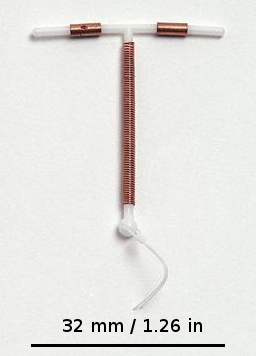
Intrauterine device
An intrauterine device (IUD), also known as intrauterine contraceptive device (IUCD or ICD) or coil,[3] is a small, often T-shaped birth control device that is inserted into the uterus to prevent pregnancy. IUDs are a form of long-acting reversible birth control (LARC).[4]
"IUD" redirects here. For other uses, see IUD (disambiguation).
Users are more satisfied with Contraceptive implants such as IUDs than any other birth control method.
IUDs are safe and effective in adolescents as well as those who have not previously had children.[5][6] Once an IUD is removed, even after long-term use, fertility returns to normal rapidly.[7] Copper devices have a failure rate of about 0.8% while hormonal (levonorgestrel) devices fail about 0.2% of the time within the first year of use.[8] In comparison, male sterilization and male condoms have a failure rate of about 0.15% and 15%, respectively.[9] Copper IUDs can also be used as emergency contraception within five days of unprotected sex.[10]
Although copper IUDs may increase menstrual bleeding and result in painful cramps,[11] hormonal IUDs may reduce menstrual bleeding or stop menstruation altogether.[12] However, women can have daily spotting for several months and it can take up to three months for there to be a 90% decrease in bleeding with hormonal IUDs.[13] Cramping can be treated with NSAIDs.[14] More serious potential complications include expulsion (2–5%) and rarely perforation of the uterus (less than 0.7%).[12][14] IUDs do not affect breastfeeding and can be inserted immediately after delivery.[12] They may also be used immediately after an abortion.[15][16]
The use of IUDs increased within the United States from 0.8% in 1995 to 7.2% from the period of 2006 to 2014.[17][18] The use of IUDs as a form of birth control dates from the 1800s.[1] A previous model known as the Dalkon shield was associated with an increased risk of pelvic inflammatory disease (PID). However, current models do not affect PID risk in women without sexually transmitted infections during the time of insertion.[19]
Cost[edit]
In the United States, the price of an IUD may range from $0 to $1,300.[89] The price includes medical exams, insertion, and follow-up visits. Under the Affordable Care Act, most insurance plans are required to cover all forms of birth control, including IUDs, although they may not cover all IUD brands.[90]
Popularity[edit]
Among birth control methods, IUDs, along with other contraceptive implants, result in the greatest satisfaction among users.[5]
A study found that female family planning providers choose LARC methods more often (41.7%) than the general public (12.1%).[91]